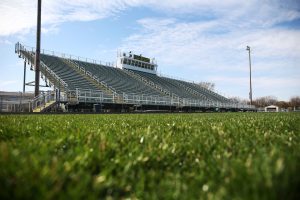Crystal Lake High School bleacher saga sparks law
Gregory Harutunian for Chronicle Media — September 7, 2016
The Crystal Lake South High School west side bleacher expansion stirred controversy, as District 155 officials acted without the city’s approval in obtaining zoning variances and permits.
The acrimony which ensued last year, between the Community High School District 155 and the city of Crystal Lake, over expanded bleachers and parking at the south high school campus has evolved into a law identifying school districts as being subject to area zoning ordinances whether in a municipal, or county, location.
Gov. Bruce Rauner signed Senate Bill 2186, which was sponsored by a host of local legislators, onto the books Aug. 25, and aligns itself with the Illinois Supreme Court decision from Sept. 24, of last year. Justices sided with city of Crystal Lake, and its directly impacted residents, resulting from a civil suit contending the school district had skirted municipal zoning laws in erecting the structures without proper permitting and the required code variances.
The larger issue concerned the ability of a school district to act autonomously from the municipal codes. Wording of the amendment states, in part, “A school district is subject to and its school board must comply with any valid local government zoning ordinance or resolution that applies where the pertinent part of the building, structure, or site owned by the school district is located (and) are declarative of existing law.”
The bill’s primary sponsors, state Sen. Pamela Althoff (R-McHenry) and state Rep. Michael Tryon (R-Crystal Lake), introduced the measure Oct. 20, 2015. Through the numerous readings to ameliorate the school code, the House Elementary and Secondary Education: School Curriculum and Policies Committee tacked on a rider to the bill, introduced by Tryon, last May.
The addendum stated, “A unit of local government must streamline the zoning application and review process for a public school district by reducing application fees, and other costs associated with a school district project to the greatest extent practicable and reflective of actual cost.”
The civil suit, filed by the city of Crystal Lake, alleged the school district acted without regard or entering the process for zoning variances or permits in erecting the bleacher additions. District 155 held that the school code provided an exemption from municipal authority, and cited approval and jurisdiction from the McHenry County Regional Office of Education on the matter.
Two McHenry Circuit Court decisions, rendered by Judge Michael Chmiel, upheld a position that school districts are not autonomous, and are subject to local building laws. The lower court ruling led to the high court hearing.
“This is absolutely a pertinent issue with other locales within the state of Illinois,” said Althoff. “The school code itself is a little gray when it comes to construction. The Regional Office of Education believes the municipality doesn’t figure in the process. Typically, the school district is aware of the zooming codes, and (needed) approval for the municipal permits.
“In the worst-case scenarios, the school districts don’t comply with the zoning, or the school district discovered construction delayed as municipalities controlled the process,” she said.
Althoff said abuses in southern and central Illinois where school districts were charged excessive fees for permits and variances in new constructions or renovations by the regulating city or county. Due to the code’s vagueness, its applications could be interpreted differently from the original intent.
“This legislation clarifies the process, introduces a specific timeline to which school districts are bound,” she said. “It’s very balanced and really addresses the inconsistencies and inaccuracies for both sides.”
“District 155 is committed to honoring these resolutions and working with the city, court, and residents to reach an amicable solution to this issue,” said Shannon Mortimer, the district’s public information officer. “We look forward to moving ahead, and the timetable is contingent upon approval of the resolutions by the court, on behalf of the other parties.
The school district had expanded its bleacher capacities, along with its parking lot, raising the ire of nearby neighbors, as a breach of legally-binding municipal protocol. The larger issue concerned the ability of a school district to act autonomously from the municipal codex, as indicated by state law.
The new and larger Crystal Lake south bleachers came at a cost of $1.18 million, and the circuit court order was completed in conjunction with impacted neighbors that abutted the school’s property on the west side of the bleachers. In the order, the east side seating is again the home section, with the press box being relocated there, and the offending west side sections were lowered to nine rows.
The Crystal Lake city council approved the plan in issuing the permits and variances, while the school district agreed to pay the city $260,000 in fines to effectively cover the city’s court costs. Code enforcement mandates could have levied a fine of between $500,000 and $5.5 million for violating zoning laws. The school district also agreed to pay $273,000 to help cover the legal costs of the neighbors.
Althoff indicated Rauner made no commentary regarding the legislation to her, but his staff was complimentary.
“They said it was a great piece of legislation that clarifies the issues,” she said. “Two taxing bodies fighting each other doesn’t serve the taxpayer or the taxpayer’s interests.”







